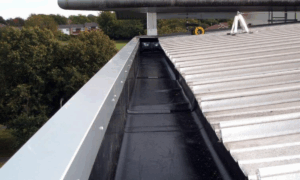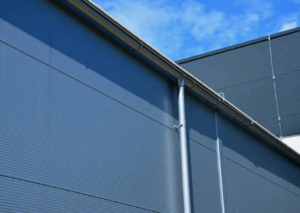When it comes to protecting commercial properties, one often overlooked but essential feature is the rain gutter system. While many property owners focus on the building’s structural elements, interior design, or landscaping, rain gutters play a critical role in ensuring the longevity and safety of a commercial building. Understanding how these systems work, what options are available, and how to maintain them can save time, money, and potential headaches in the long run.
Why Rain Gutters Matter for Commercial Buildings
 Rain gutters are designed to direct water away from a building’s foundation, walls, and entrances. In a commercial setting, where the size of the roof and the volume of water runoff can be substantial, having a well-designed and functioning gutter system is not just beneficial—it’s essential. Without an adequate gutter system, water can accumulate around the foundation, potentially causing erosion, leaks, or even structural damage over time.
Rain gutters are designed to direct water away from a building’s foundation, walls, and entrances. In a commercial setting, where the size of the roof and the volume of water runoff can be substantial, having a well-designed and functioning gutter system is not just beneficial—it’s essential. Without an adequate gutter system, water can accumulate around the foundation, potentially causing erosion, leaks, or even structural damage over time.
Additionally, poorly managed rainwater can lead to issues like flooded walkways, slippery entry points, and property damage, all of which can create safety hazards and liability concerns. For commercial property owners and managers, these risks could result in costly repairs or legal issues, making proactive planning and investment in gutters a smart decision.
Types of Commercial Rain Gutters
Commercial buildings often require more robust and higher-capacity gutter systems than residential homes due to their size and unique architectural features. While there are various materials and styles available, the most common types include K-style gutters, box gutters, and custom-fabricated options.
K-style gutters, though more common in residential settings, may be used in smaller commercial buildings. Box gutters, however, are specifically designed for larger-scale water collection and are typically integrated into the structure’s roofline. These are ideal for flat or low-slope roofs, which are commonly found in commercial designs.
Material choice also plays a role. Aluminum is lightweight and resistant to rust, making it a popular choice. Steel gutters offer greater strength and durability, which can be beneficial in areas with heavy rainfall. Copper is also an option for commercial properties seeking a premium, long-lasting material that requires minimal maintenance and offers a distinctive look.
Design Considerations for Maximum Efficiency
Selecting the right gutter system is about more than just aesthetics. Several design factors must be considered to ensure maximum efficiency and durability. Roof size, pitch, and the average rainfall in the area are primary considerations. A larger or steeper roof will require a gutter system with a higher capacity to handle the increased volume of water runoff effectively.
Downspout placement is also critical. Properly positioned downspouts allow water to exit the system quickly and be directed safely away from the building’s foundation. Without well-planned downspout placement, even the most efficient gutter system can become overwhelmed during a heavy storm, leading to overflows and potential damage.
Furthermore, the integration of leaf guards or screens can prevent debris buildup, which is especially helpful for commercial properties surrounded by trees or located in areas with frequent storms. These additions can reduce maintenance needs and extend the system’s lifespan.
Maintenance and Longevity
 As with any component of a commercial building, regular maintenance is key to preserving the functionality of a rain gutter system. While many modern gutter systems are designed for durability, they still require periodic inspection and cleaning to prevent blockages and damage.
As with any component of a commercial building, regular maintenance is key to preserving the functionality of a rain gutter system. While many modern gutter systems are designed for durability, they still require periodic inspection and cleaning to prevent blockages and damage.
Clogged gutters can result in water overflow, which undermines their primary purpose. Over time, stagnant water can also lead to rust or deterioration in certain materials. Property owners should schedule routine inspections, especially after severe weather, to check for any signs of wear, sagging, or separation from the roofline.
Engaging a professional maintenance service is often a wise investment for commercial properties. These experts can conduct thorough inspections, perform cleanings, and make any necessary repairs before small issues become costly problems.
Compliance and Building Codes
When installing or upgrading rain gutters on commercial properties, compliance with local building codes and regulations is crucial. Depending on the location and type of commercial structure, there may be specific requirements regarding the design, size, and materials used for gutter systems.
Building codes are designed not only to ensure the functionality of gutter systems but also to address public safety and environmental concerns. For example, some areas may require gutter systems to be integrated with stormwater management solutions, such as rainwater harvesting systems or underground drainage.
Working with a licensed contractor who understands regional codes can help avoid fines, ensure long-term performance, and provide peace of mind that the system meets all necessary standards.